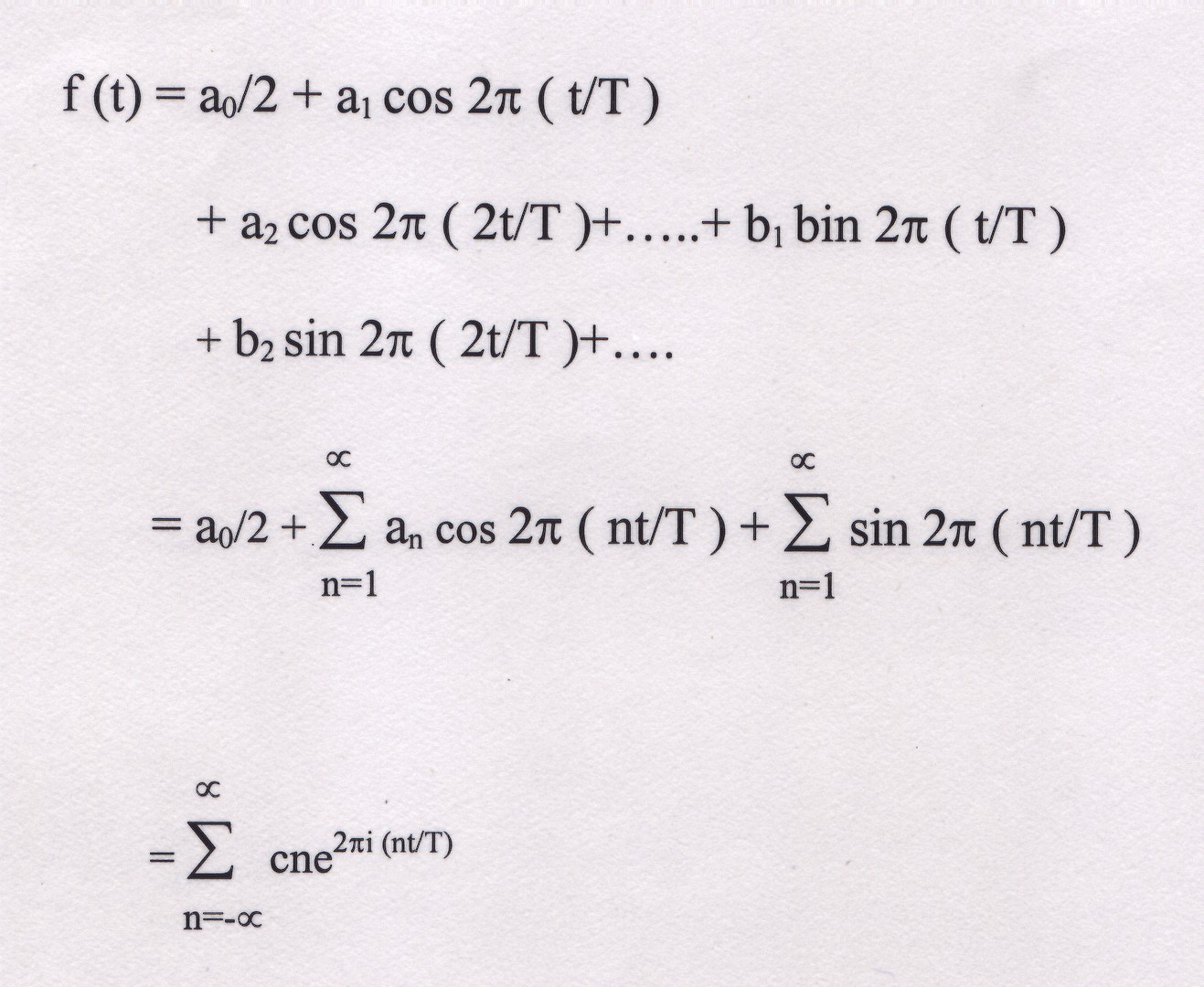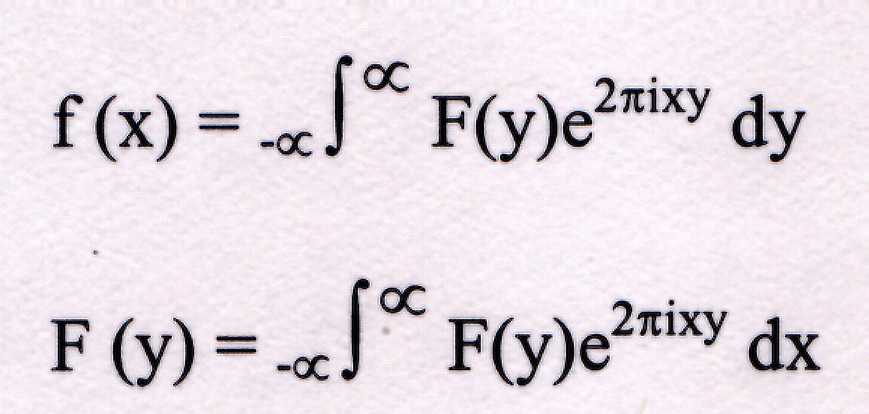| FTGPRED: Gene Identification using Fourier Transformation |
| Fourier Transformation |
The Fourier Transform , in essence, decomposes or separates a waveform or function into sinusoids of different frequency which sum to the original waveform. It identifies or distinguishes the different frequency sinusoids and their respective amplitudes.
The Fourier Transform is based on the discovery that it is possible to take any periodic fuction of time x(t) and resolve it into an equivalent infinite summation of sine waves and cosine waves with frequencies that start at 0 and increase in integer multiples of a base frequency f0 = 1/T, where T is the period of x(t).
Joseph Fourier (1768-1830) was a french mathematician and physicist who, because of his interest in heat conduction, developed a mathematical method for the representation of any discontinuous function in space or time in terms of a much simpler trigonometric series of continuous cosine or sine functions. Such a series is referred to as a Fourier Series and the process of dissection into cosine and/or sine components is called Fourier Analysis . The opposite or inverse operation, recombining cosine and/or sine functions, is called Fourier synthesis.
If a metal bar is heated, the temprature of the bar is highest at the point where it is heated and this heat then spreads through the whole bar. Taking temperature as a function of distance along the bar we see that this is an example of a discontinuous function. Fourier realised that, if the temperature was decomposed into continuous sinusoidal curves having 1,2,3 or more cycles along the bar, then summation of these would yield a good approximation of the original discontinuous function. The more curves added to Fourier series, the better the agreement of the Fourier synthesis with the experimental measurement.
Any wave function can be defined in terms of amplitude, A, and wave-length, ![]() or frequency, v . A full description of such a wave also requires definition of a phase, phi . A simple one-dimensional wave-function, f(x), specifies the height of the wave at any horizontal point x where x is defined in terms of wavelength such that x=1=
or frequency, v . A full description of such a wave also requires definition of a phase, phi . A simple one-dimensional wave-function, f(x), specifies the height of the wave at any horizontal point x where x is defined in terms of wavelength such that x=1=![]() . This wave function could be represented as either a sine or a cosine function as follows:
. This wave function could be represented as either a sine or a cosine function as follows:


The term 2pi appears because there are 2 radians per wavelength. Fourier analysis of complex wave functions dissociates them into a Fourier series of simple wave functions such as f(x). We could write a Fourier series containing n terms as

This shows that any complex wave can be expressed as a composite of simpler cosine or sine waves. If a complex discontinuous function is periodic (although this is not essential ) with a period T such that f ( t + T ) = f ( t ), it may be represented as a Fourier series of the form

where t is time, n is the number of components in the series, i is the imaginary number (= -1)1/2 and a, b, c etc. are coefficients describing the individual waves in the series. This mathematically expresses the fact that a discontinuous function can be dissected into individual sine/cosine wave functions which may in turn be summed to arrive at an expression for it as a function ( in this case ) of time. The relationship between the two sets of functions can be generalised with a pair of equations which are Fourier transforms of each other.

A good practical analogy for Fourier analysis is the diffraction of white light from the sun after passage through a prism into waves of individual frequency and amplitude. The strength of sunlight incident on the prism may be expected to vary with time which, in turn leads to variation in the amplitude of each diffracted frequency. The prism therefore acts to transform a strength-time domain into an amplitude-frequency domain.
The Fourier transform is special because the equation relating sets of numbers which can be interconverted by the Fourier transform contains sine and cosine terms allowing us to relate the complex wave to a series of simpler waves in a fixed and meaningful way. This allows us to determine unknown discontinuous experimental functions such as the electron density of an atom (a function in space) or the electromagnetic spectrum of a molecule (the time-inverse function, frequency).
The reason the Fourier transform is so widely used is that it offers specific computational advantages over other mathematical approaches. However complex the Fourier series, it is related to the original function by a comparatively simple equation making it possible to move from the real-world domain of space or time to the Fourier domain of frequency, phase and amplitude. Moreover, considerable error can accumulate due to shortcomings in real-world experimental systems such as those used in diffraction or spectroscopy. Development of fast Fourier transform algorithm has facilitated very rapid calculation by computer in the Fourier domain which can smooth out and diminish this error resulting in a more accurate overall measurement. The Fourier transform therefore provides a computationally versatile tool to analyse complex functions arising from experimental measurements by dissecting them into simpler wave functions which can be used to determine experimental unknowns.
FFT-FAST FOURIER TRANSFORMATION IN BIOLOGICAL SEQUENCE ANALYSIS::
The analysis of correlations in DNA sequences is an important complement to experimental studies to identify protein coding genes in genomic DNA. Several groups have tried Fourier transformation as a means to identify the protein coding genes (Ramaswamy et al., 1999; Herzel et al., 1999; Yan et al., 1998; Tiwari et al., 1997; Widom, 1996). What is the basis to use FT on biopolymers? The answer lies in the composition of the DNA sequence itself.
Tandem repeats and periodic clusters are often found in biological sequences (DNA and Proteins) and locating and characterizing them may provide certain information about the structural and functional characteristics of the molecule. In the recent past two methods have emerged to locate exact or approximate repeat regions, Fourier analysis and internal homology study.
The search for periodicity in the gene sequences has in the past has produced some interesting ideas on the origin of the genetic code and the principles underlying its construction. Analyzing the coding sequences for RNY periodicity Shepherd, (1982) observed that codons of RNY (purine=R; any=N; pyrimidine=Y) form seem to be the predominant codon structure in most DNA sequences, suggesting it to be the most primitive codon. A primitive message composed exclusively of RNY codons could have been translated in only one of 3 possible frames, circumventing the need for special start signals to fix the reading frame. Interestingly, among the 8 amino acids specified by RNY in today's code (GLY, ILE, THR, ASN, SER, VAL, ALA & ASP) are amino acids that are most likely to have been generated by prebiotic synthesis, as well as those that often appear in meteorites (Watson et al., 1987).
Tsonis et al., (1991) employed Fourier analysis of DNA coding and non-coding sequences in an attempt to identify possible patterns in gene sequences. They found that while intronic sequences show a rather random pattern, coding sequences show periodicities and in particular a periodicity of 3. They inferred that the predominant presence of codons all starting from the same base could confer the observed periodicities.
Modern genetic information carrying DNA sequences are thought to have evolved from ancestral primordial blocks which were single-stranded (RNA) oligonucleotides produced by random polymerization of nucleotides. Discovery of RNA introns, that can act as enzyme, points to the fact that these blocks could be replicated or fused to produce repeating units without use of proteins. Some authors have suggested that these short repeating units formed the basis for the generation of longer sequences by becoming progressively longer and less homologous to each other.
ELABORATION OF THE PERIODICITY FOUND IN THE SPECTRA::
In order to completely understand the properties of the sequences that are imprinted on the Fourier spectra let us consider the periodic sequence A--A--A--A--..... where blanks can be filled randomly by A, C, G or T. This sequence shows a periodicity of three because of the repetition of the base A. The spectral density of such sequence is significantly non-zero only at one frequency (0.33) which corresponds to the perfect periodicity of base A (1/0.333=3.0). In other words, for this sequence a continuous background does not exist.

This definitely is not the case with the coding sequences where the spectral density because: a) has a much lower value at frequency 0.333 and b) shows significant activity at all frequencies. Returning to the sequence A--A--A--A--..... , destroy the perfect repetition of base A by randomly replacing it with G, C or T.

The spectral frequency value at frequency 0.33 has been reduced to a very similar to that observed in real coding sequences, while at the same time we observe activity at all frequencies due to the random break-up of the perfect repetition of base A.

These results indicate that certain periodicities are detectable in coding sequences. This periodicity is not however perfect (as expected for real coding sequences), but broken in many places and provide a mechanism in explaining the global structure of coding sequences (Tsonis et al., 1991).